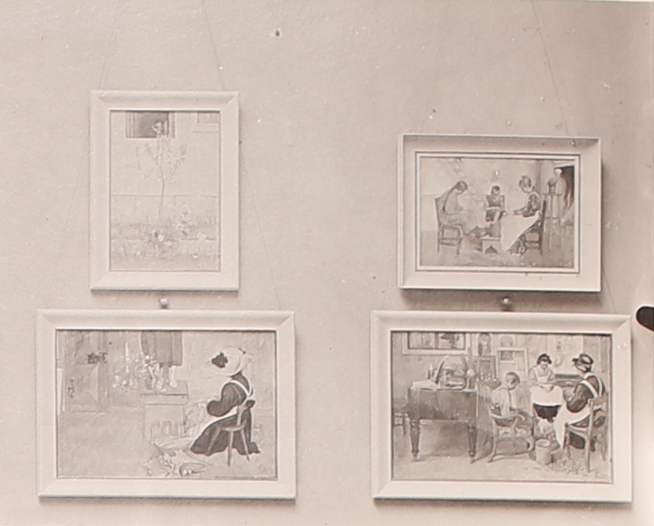Carl Larsson
"Dom spritar ärter"/ "Ärtspritning"
Signerad C.L. inom cirkel och daterad 1908. Akvarell 53 x 75 cm.
Införselmoms
Införselmoms (12%) tillkommer på klubbat pris. För ytterligare information vänligen kontakta kundservice, alternativt +46 8-614 08 00.
Proveniens
Gåva till Redaktör Richard Gustafsson av konstnären 1913.
Fru Thérèse Gustafsson.
Fru Ebba von Lesser, född Gustafsson.
Privat samling.
Utställningar
Vandringsutställning "Åt solsidan", 1909-1914.
Liljevalchs konsthall, Stockholm, "Invigningsutställning - Larsson-Liljefors-Zorn", mars - april, 1916, kat. nr 82. (under titel "Ärtspritning", då tillhörande Redaktör Rich. Gustafsson).
Charlottenborg, Köpenhamn, "Svenska konstutställningen", november - december, 1916, kat. nr 473 (under titeln "Dom spritar ärter).
Liljevalchs konsthall, Stockholm "Minnesutställning - Carl Larsson", 6 mars - 5 april, 1920, kat. nr 232. (under titel "Ärtspritning", då tillhörande Fru Thérèse Gustafsson).
Liljevalchs konsthall, Stockholm, " Carl Larsson- Bruno Liljefors- Anders Zorn", 9 juli - 17 augusti, 1930, kat. nr 51. (under titel "Ärtspritning", då tillhörande Fru Ebba von Lesser, född Gustafsson).
Blaafarvevaerket i Modum, Norway, "Hipp-hipp-hurra! 30 år med skandinavisk kunst på Blaafarvevaerket ", 19 maj - 23 september, 2007, kat. nr 31, avbildad helsida i färg s. 45.
Lillehammer Kunstmuseum, Norge, "Å hjemme seg. I Sigrid Undsets hus er det mange rom", 20 maj - 27 oktober, 2019.
Litteratur
"Carl Larsson -Skildrad av honom själv i text och bilder -En krönika sammanställd av Harriet och Sven Alfons", 1952, avbildad halvsida s. 217.
Ulwa Neergaard, "Carl Larsson. Signerat med pensel och penna", 1999, avbildad i färg s. 413 samt upptagen i katalogsupplementet under år 1908, som nr 1265.
Lena Rydin, "Den lustfyllda vardagen - Hos Larssons i Sundborn", 1992, avbildad i färg s. 136.
Övrig information
26 december 1913 skriver en Richard Gustafsson till sin vän Carl Larsson för att tacka för julklappen. Han beskriver i brevet hur han och familjen firat julafton hos hans äldsta son och när de kommit hem igen sent för att överraskas av att ”en vänlig tomte varit uppe på berget och där lämnat efter sig en julklapp”. Gåvan var den aktuella målningen "Dom spritar ärter/ Ärtspritning" utförd av Carl Larsson 1908. Han skriver även:
”Jag har förut ett par bilder från din hand… från din ungdom… och de har alltid varit mig kära, men den tafla, som du nu begåfvat mig med, skall helt visst fördubbla min ålders glädje, ty den är typen för den genre med hvilken du etsat dig in i det svenska folkets hjärta. Så länge mitt öga kan se skall jag glädjas åt din ljusa bild från dynastien Larsson[…]”
Som Gustafsson beskriver så är målningen en skildring av konstnärens familj i ateljén i Lilla Hyttnäs i Sundborn. Vi ser hustrun Karin tillsammans med de två yngsta barnen Kersti och Esbjörn sitta djupt försjunkna i ärtspritning. I en kommentar till målningen skriver konstnären: ”Ja till och med det begå de, Karin, Brita och Esbjörn i min ägandes atelier! Jag är en mes!” Bakom familjen skymtar man en storskalig skiss för Larssons plafondmålning ”Dramats skapelse” för Dramatens stora marmorfoajé. Den står mot väggen bakom den stege Carl Larsson förmodligen använde för att nå med kritan över den stora ytan.
I "Dom spritar ärter/ Ärtspritning" strålar solen in i ateljén och fyller rummet med ljus, en aspekt som berör temat för Carl Larssons bok ”Åt solsidan” från 1910 där målningen är inkluderad. Han förklarar boktiteln såhär i den inledande paragrafen: ”Åt solsidan. Så skall boken heta denna gång. Nog ha vi fönster åt alla sidor, men det är naturligtvis i symbolisk bemärkelse som namnet blef det det blef. Ty vi vilja ha sol in o lifvet liksom in i rummen”.
Bakom Karin har konstnären målat en kaktus på ett högt blomställ varifrån en blomma växt fram. Blommor och växter var en viktig del i Carl Larsson konstnärskap. Han skriver i ”Åt solsidan”: ”Oftast är det en blomma som först får makt med mig och jag får ej ro i min själ innan jag målat af henne […]”. Även Karins klänning blir en möjlighet för Carl Larsson att studera och fånga naturens sirligt dekorativa egenskaper. Den blåa klänningen med vita blommiga detaljer återkommer i målningen ”Brudtärnan”, även den utförd 1908 och inkluderad i ”Åt solsidan”. Tillsammans med skissen till Dramatens plafond i bakgrunden skapar klänningen en kontrast till möblernas skarpa linjer vilket bildar en komposition fylld av dynamik.
Konstnär
Carl Larsson räknas som en av de största svenska konstnärerna genom tiderna. Han föddes i Gamla Stan i Stockholm och studerade vid Kungliga Konstakademin åren 1866-76. Efter studierna i Stockholm reste han till Frankrike och bosatte sig i Grèz-sur-Loing, dit också andra konstnärer sökte sig. Där utförde han främst målningar med trädgårdsmotiv. I Frankrike träffade han sin blivande maka Karin Bergöö, som också var konstnär och kom att betyda mycket för hans produktion. Redan under studieåren försörjde han sig som fotoretuschör och som tecknare i pressen. Det var också under studietiden som Larsson lärde känna Anders Zorn och Bruno Liljefors, tillsammans brukar de tre kallas för ABC-konstnärerna. I slutet av 1880-talet fick paret Larsson ”Lilla Hyttnäs" i Sundborn utanför Falun av Karins far och det är där Larssons mest kända akvareller som skildrar hans familj kommer till. Motiven föreställer ofta soliga landskap med badande och metande barn, kräftfiske, måltider i det gröna samt interiörscener. Larsson är bland annat representerad i Nationalmuseum där väggmålningen ”Gustav Vasas intåg i Stockholm” och ”Midvinterblot” fyller trapphallen. Väl representerad främst på Nationalmuseum i Stockholm och på Göteborgs Konstmuseum.
Läs mer
































































